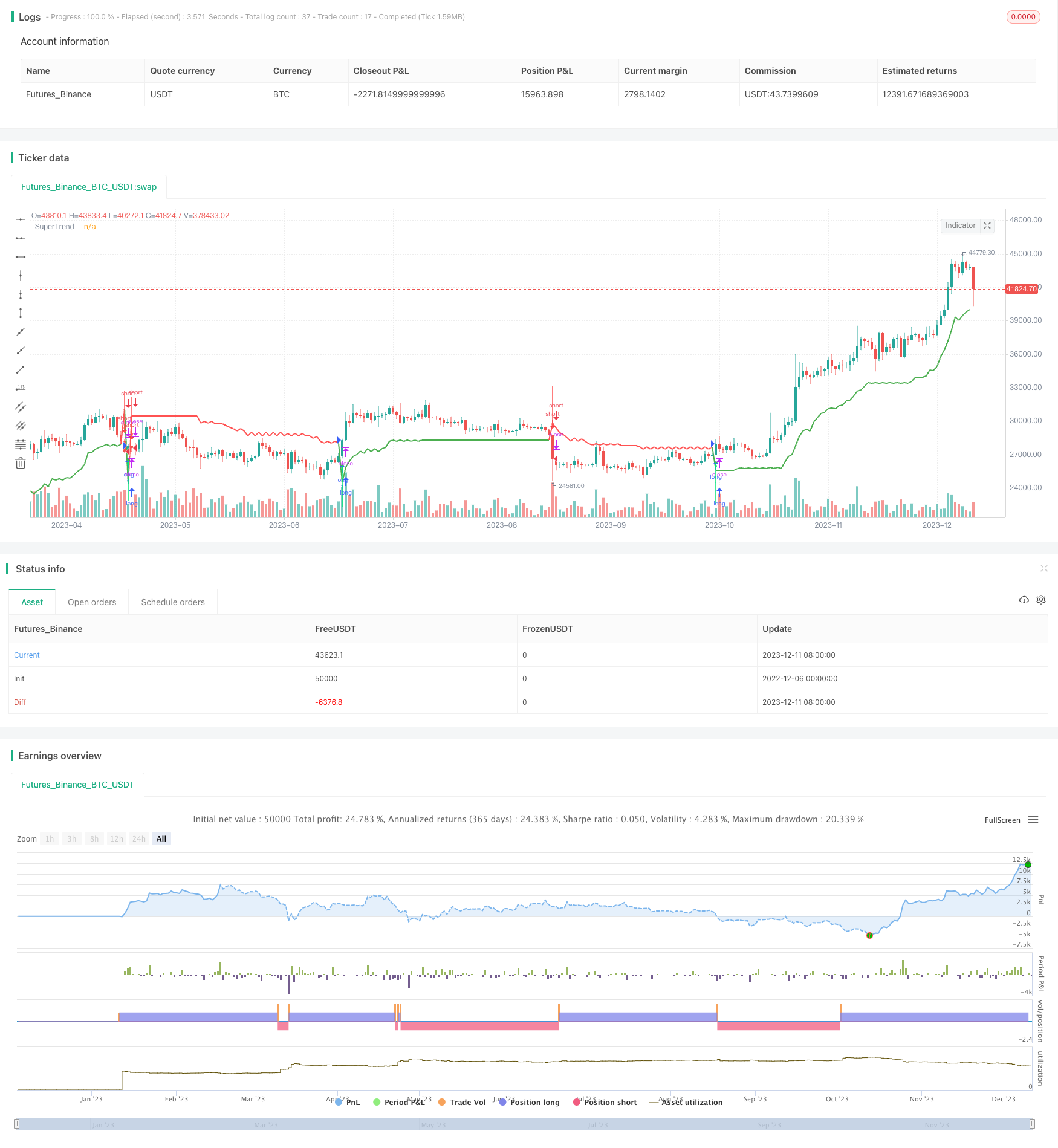
概述
本策略展示了如果盲目跟随超趋势指标会发生什么情况。我们知道,超趋势指标不是立即出现的,我们需要等待下一根K线才能决定是否进入仓位。所以,你可以看到,如果在超趋势指标最终形成后才入场,会发生什么。如果没有其他工具的辅助,这个指标非常危险,可能会带来非常大的回撤。请注意资金管理。
策略原理
本策略使用超趋势指标判断价格趋势。超趋势指标基于平均真实波幅和高低价中点构建。
当收盘价高于上轨时,代表持续看涨;当收盘价低于下轨时,代表持续看跌。
本策略设置了Factor和Pd两个参数。Factor控制超趋势通道的宽度,Pd控制计算ATR的周期长度。根据这两个参数可以构建上轨和下轨。
上轨公式:hl2 - (Factor * ATR(Pd)) 下轨公式:hl2 + (Factor * ATR(Pd))
其中hl2代表高低价中点。
然后比较当前收盘价与上下轨,判断持续看涨还是看跌,输出布尔型的Trend变量。
根据Trend来绘制超趋势的上下轨。并在Trend状态发生变化时,放置入场和出场信号。
根据信号设置策略的开仓逻辑。
优势分析
本策略具有以下优势:
使用了超趋势指标,可以清晰判断价格趋势和枢轴点。
设置了明确的入场和出场逻辑。
可视化通过箭头标注入场时机。
策略逻辑简单易懂。
风险分析
本策略存在以下风险:
盲目跟随超趋势指标,没有其它辅助指标和效果管理,可能带来巨大回撤。
没有设置止损,无法控制单笔损失。
信号可能出现滞后,无法在转折点附近及时入场。
参数设定不当可能导致超趋势通道过于宽泛或过于狭窄。
风险管理措施:
结合其他指标如MACD、KDJ等进行效果验证,避免盲目跟随。
设置合理的止损位,最大限度控制单笔损失。
调整参数,使超趋势通道合理,防止过于宽泛或狭窄。
优化方向
本策略可以从以下方面进行优化:
增加辅助指标进行效果验证,防止失效。例如可以考虑加入MACD指标。
设置合理的止损逻辑。可以基于ATR来设置百分比止损。
对超参数Factor和Pd进行优化,找到最佳参数组合。例如可以采用遍历的方法寻找最优参数。
对入场时机进行优化,避免信号滞后。例如可以引入动量指标判断强弱格局调整入场时机。
增加仓位管理策略。例如可以采用固定份额进行仓位管理。
总结
本策略采用超趋势指标判断价格趋势和找出转折点。由于缺乏辅助指标和止损手段,盲目跟随超趋势指标带来巨大风险。我们提出了在风险管理、止损策略、参数优化、入场时机等多个方面进行改进,可以显著增强策略的稳定性和盈利能力。
/*backtest
start: 2022-12-06 00:00:00
end: 2023-12-12 00:00:00
period: 1d
basePeriod: 1h
exchanges: [{"eid":"Futures_Binance","currency":"BTC_USDT"}]
*/
//@version=2
strategy("Supertrend blind follow", overlay=true)
Factor=input(3, minval=1,maxval = 100)
Pd=input(7, minval=1,maxval = 100)
Up=hl2-(Factor*atr(Pd))
Dn=hl2+(Factor*atr(Pd))
TrendUp=close[1]>TrendUp[1]? max(Up,TrendUp[1]) : Up
TrendDown=close[1]<TrendDown[1]? min(Dn,TrendDown[1]) : Dn
Trend = close > TrendDown[1] ? 1: close< TrendUp[1]? -1: nz(Trend[1],1)
Tsl = Trend==1? TrendUp: TrendDown
linecolor = Trend == 1 ? green : red
plot(Tsl, color = linecolor , style = line , linewidth = 2,title = "SuperTrend")
plotshape(cross(close,Tsl) and close>Tsl , "Up Arrow", shape.triangleup,location.belowbar,green,0,0)
plotshape(cross(Tsl,close) and close<Tsl , "Down Arrow", shape.triangledown , location.abovebar, red,0,0)
//plot(Trend==1 and Trend[1]==-1,color = linecolor, style = circles, linewidth = 3,title="Trend")
plotarrow(Trend == 1 and Trend[1] == -1 ? Trend : na, title="Up Entry Arrow", colorup=lime, maxheight=60, minheight=50, transp=0)
plotarrow(Trend == -1 and Trend[1] == 1 ? Trend : na, title="Down Entry Arrow", colordown=red, maxheight=60, minheight=50, transp=0)
longCondition = cross(close,Tsl) and close>Tsl
if (longCondition)
strategy.entry("long", strategy.long)
shortCondition = cross(Tsl,close) and close<Tsl
if (shortCondition)
strategy.entry("short", strategy.short)